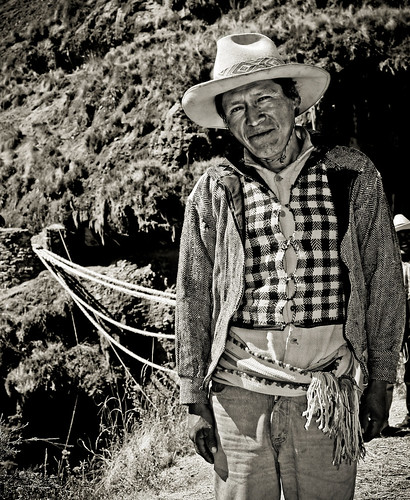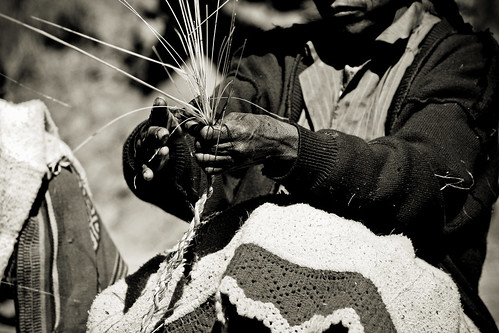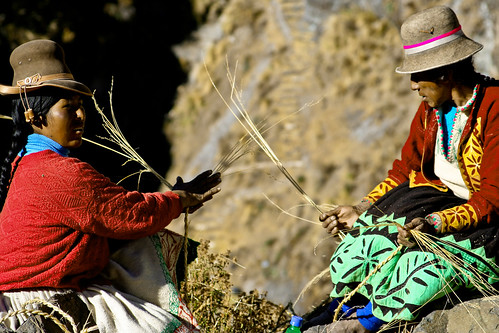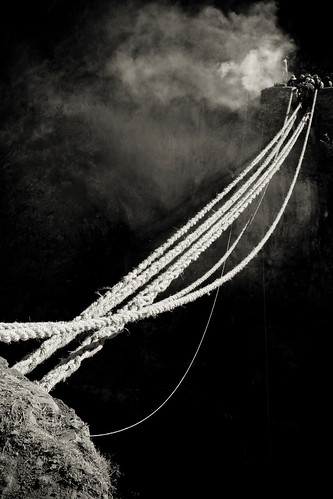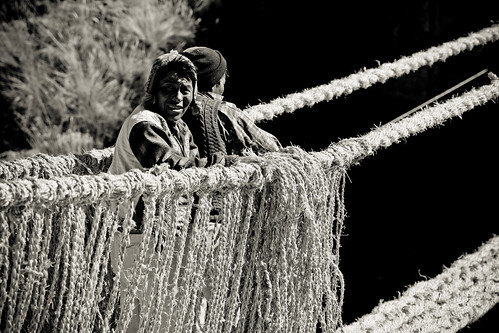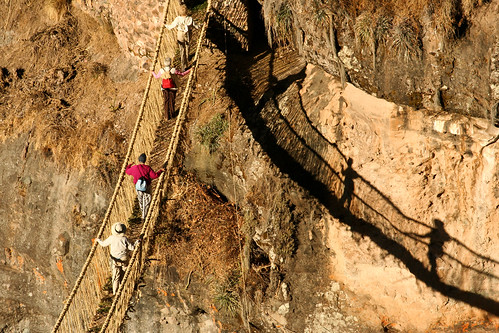Photos of the bridge building can be seen HERE, and also on my website at www.dojoklo.com in the Inca Bridge gallery.
Videos of the bridge can be seen HERE
Rolando stopped the taxi right in front of the group of women weaving straw ropes, sitting by the side of the road. Their kids immediately ran to the window, “Propina, propina, carameletto?” Oh no, I thought, I haven´t even gotten out of the car yet and they’re asking for handouts. As soon as I pulled myself out and gathered my backpack and tent, the chorus of women started: “Propina gringito, propina. Carameleto para los niños?” – “Tip, little white boy. Candy for the kids?” My goodness! They even sounded a bit angry that the money and sweets hadn’t started to flow from my pockets. And I haven’t even pulled out my camera yet! I came here with the hopes of spending three days taking award winning, up-close photos, and the women were already not pleased with my presence. Is this how the next three days were going to be?
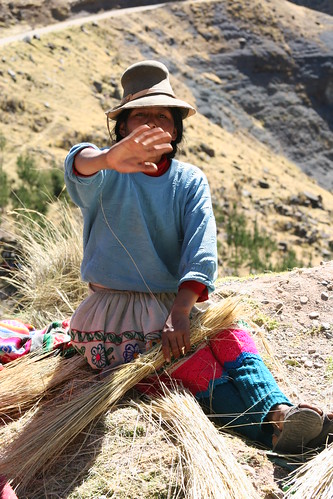
My welcoming committee, as I exited the taxi and immediately began taking photos.
I had headed south from Cusco on Friday morning and took a bus for two and a half hours to Combapata. From there I switched to a collective taxi, and joined 9 other people as I crammed myself into the back of a tiny hatchback station wagon. As an unshaven old man slept on my shoulder we slowly wove our way through herds of cows and sheep being led down the road, and forty minutes later, after picking up yet another passenger, everyone got out in Yanaoca. I had thought we were going all the way to Huinchiri, but now I discovered I was the only one who wanted to go there. Since the festival wasn’t until Sunday, neither locals nor tourists were heading to the bridge site yet. So while it cost 2 soles to go the previous forty minutes, it was going to cost me 70 soles for the next hour and a quarter to Huinchiri! I sat in disbelief in the car, refusing to get out. I knew there were no other options, but I quizzed the driver. “Are there any other cars going? Any trucks, any buses?” “No, not until Sunday.” “But 70 soles?!” I responded. “I haven’t brought enough money. I’ll never be able to get back!” I tried to bargain with him, and soon started to beg. “But you only charge 2 soles per person going back and forth all day. How much do you make in a couple hours? 30, 40 soles?” “Yes, but the road is very rough, full of rocks,” he replied. We sat in silence for awhile, and every couple minutes I went up 10 soles. “50? 60?” But 65 soles was the best I could get out of him “Sesenta?” I kept trying, just for a personal feeling of accomplishment. “Mas cinco,” he insisted. Finally I had to agree: 65 soles.

A view along the way between Yanaoca and Huinchiri.
He was right. The road was terrible. We wound our way through dry grassland, with herds of cows and sheep and alpacas feeding on the q’oya grass that was the same material used to construct the bridge. There were mud huts with thatched roofs, and precariously constructed stone walls meandering across the low hills. At one point he gestured to a distant hill, “Atras, atras,” telling me the bridge was behind.
Along the way I realized that the bone jarring ride was probably doing at least 65 soles of damage and wear and tear to the taxi. After an hour we reached a gate across the road, with a couple of locals attending it. A handwritten sign was posted: Taxis – 5 soles, Camiones – 10 soles, Turistas – 70 soles. 70 soles for tourists! My heart sunk into my stomach. I´m never going to have enough money to get back, I thought. The taxi driver talked to the men for a bit, then turned to me asking for 2 soles. I quickly fished the money out of my pocket, discreetly hid my camera so I would look less like a tourist – if that was at all possible – and didn´t ask any questions. While I got in cheaply, it wasn´t until perhaps two days later that I realized “Turista” likely meant 70 soles for an entire tourist bus.

A couple of the “Quince curvas” of the road winding down to the site.
We passed through the gate, climbed over the top of the last hill, and began the descent to the river valley. “Quince curvas,” he told me – fifteen distinct, precarious turns in the road. I caught my first glimpse of the bridge far below, but it quickly disappeared. I saw a few tents in a pasture several hundred yards beyond. Then he dropped me off in front of the women.
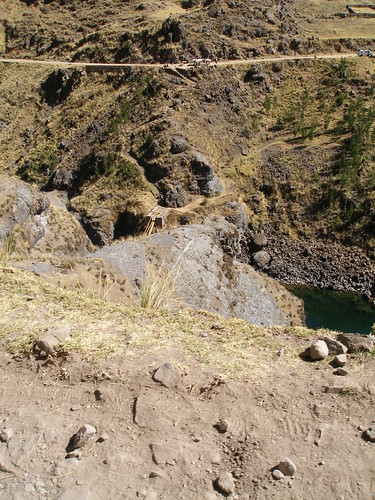
Where I was dropped off. The bridge is right below, the weaving women just to the left, and the campsite in the distant top-right, to the right of the bus. The abutment of the far side of the bridge can be glimpsed in the center.
to be continued…
